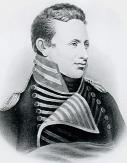Smith, Hagerman & Colglazier, LLC
620-285-3157
Santa Fe Trail
At the confluence of where the Pawnee River met the larger Arkansas River is the "Pawnee Fork." The town of Larned was begun at this site in 1872. But the area,
historically, is older.
The town of Larned was begun at this site in 1872. But the area,
historically, is older.
Join the teamsters of the SFT and "ride the box" along the way:
Santa Fe Trail - U.S. National Park Service

"Riding the box" was what the teamsters called sitting on the hard bench seat of a freight wagon.

Francisco Vásquez de Coronado

Zebulon Pike

John Charles Frémont
In 1806, explorer Zebulon Pike sent an expedition to follow the Arkansas River to Pawnee Fork, then turned west to the unnamed territory of what became Colorado, where he saw and named a mountain in his honor. In 1845, John C. Frémont also mapped and explored the area around Larned, assisting survey parties along the Santa Fe Trail.
When rain-swollen, the rivers at Larned were wide and rapid and several soldiers and civilians were swept to their deaths trying to corduroy a road for heavy freight wagons crossing the ford.
The Santa Fe Trail was the main artery of commerce on the plains from the Lewis & Clark era in 1804 to the post civil war era of transcontinental railroads. Development of the Trail in large part contributed to the war with Mexico in 1846, which brought huge tracts of land into the United States under the banner of Manifest Destiny. Over time, these tracts became all or part of ten new states of the Union.
All images and graphics are public domain unless otherwise noted.